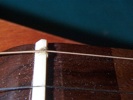Controlling Sustain
Controlling the sustain of a dulcimer's voice is critical to the perception of tonal quality, and must be adapted to suit the needs of whatever music the instrument will usually be playing.
Adequate sustain is critical to a properly set up dulcimer. Too little and the music just dies. Too much will make rapid playing become muddy. There are two methods I use to reduce sustain (I've never built an instrument that didn't have enough sustain):
- Saddle and nut material. My preferred use for the saddle and nut is bone. I process raw cow shanks and cut them myself to insure high quality bone goes into every nut and saddle. If there is a great deal too much sustain I will use alternate hardwood nut or saddle, depending on whether the problem is in the open string only or in fretted string positions also.
- Ebony yields a slightly mellower tone and yields some damping
- Rosewood yields even more mellow tone and more damping
- Parchment dampening. For maximum dampening a small square of animal skin parchment is placed under the string at the nut or saddle, depending on where the problem is.
Here are two views of the parchment damper in use on the bass string at the saddle. If you lose this damper during string changes you will need a spare (supplied with the instrument) and a fine tweezers to replace it.

 The view at left shows the damper installed. The view at right shows the damper being installed. To install, first wet the damper to soften it (which should happen with a minute or so). These dampers are about 1/16" square, so you will have to handle them with tweezers. After the parchment is pliable, loosen the string it is to be applied for and move the string out of the way. Place the parchment square so that it overlaps a bit on both the rear and forward faces of the nut or saddle. Replace the string and gently turn the tuner or peg just enough to seat the string firmly into the parchment. Now use toothpicks wedged under the strings to form the damper so that it hugs the contours of the nut or saddle (see view at right). Leave this forming in place until the parchment has dried somewhat -- maybe an hour, haven't measured that yet!
The view at left shows the damper installed. The view at right shows the damper being installed. To install, first wet the damper to soften it (which should happen with a minute or so). These dampers are about 1/16" square, so you will have to handle them with tweezers. After the parchment is pliable, loosen the string it is to be applied for and move the string out of the way. Place the parchment square so that it overlaps a bit on both the rear and forward faces of the nut or saddle. Replace the string and gently turn the tuner or peg just enough to seat the string firmly into the parchment. Now use toothpicks wedged under the strings to form the damper so that it hugs the contours of the nut or saddle (see view at right). Leave this forming in place until the parchment has dried somewhat -- maybe an hour, haven't measured that yet!
You can also use these parchment dampers to raise the action a tiny bit. Often that will be enough to cure a buzzing string that has arisen because of wear in the nut or saddle slot.

